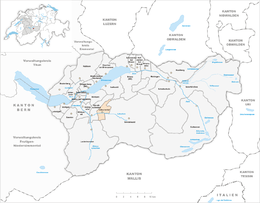Lütschental
| Lütschental | ||
|---|---|---|

Schwarze Lütschine river in Lütschental village
|
||
|
||
| Coordinates: 46°38′N 7°57′E / 46.633°N 7.950°ECoordinates: 46°38′N 7°57′E / 46.633°N 7.950°E | ||
| Country | Switzerland | |
| Canton | Bern | |
| District | Interlaken-Oberhasli | |
| Area | ||
| • Total | 12.35 km2 (4.77 sq mi) | |
| Elevation | 714 m (2,343 ft) | |
| Population (Dec 2015) | ||
| • Total | 219 | |
| • Density | 18/km2 (46/sq mi) | |
| Postal code | 3816 | |
| SFOS number | 0586 | |
| Surrounded by | Grindelwald, Gündlischwand, Iseltwald, Lauterbrunnen | |
| Twin towns | Bettlach (Switzerland) | |
| Website |
www SFSO statistics |
|
Lütschental is village and a municipality in the Interlaken-Oberhasli administrative district in the canton of Bern in Switzerland.
Lütschental is first mentioned in 1238 as Liscinthal. In 1275 it was mentioned as Lyzental.
During the Middle Ages the Lütschine valley was part of the Herrschaft of Unspunnen. During the 13th and 14th centuries, Interlaken Abbey acquired land and rights in the village until they eventually owned most of the land and people in the area. In 1349 the residents of the village joined other villages in the Bernese Oberland in an unsuccessful rebellion against the Abbey. In 1528, the city of Bern adopted the new faith of the Protestant Reformation and began imposing it on the Bernese Oberland. Lütschental joined many other villages and the Abbey in an unsuccessful rebellion against the new faith. After Bern imposed its will on the Oberland, they secularized the Abbey and annexed all the Abbey lands. Lütschental became a part of the Bernese bailiwick of Interlaken.
Beginning in the late 19th century, the population of the village dropped as residents moved to the cities of the Swiss Plateau or emigrated in search of jobs. The construction of a power plant for the Jungfrau railway, in 1908, provided more jobs but was unable to stop the population decline. Today some residents raise livestock in alpine meadows or work in the small tourism industry. About half of the working population commute to jobs in the nearby municipality of Grindelwald.
...
Wikipedia



